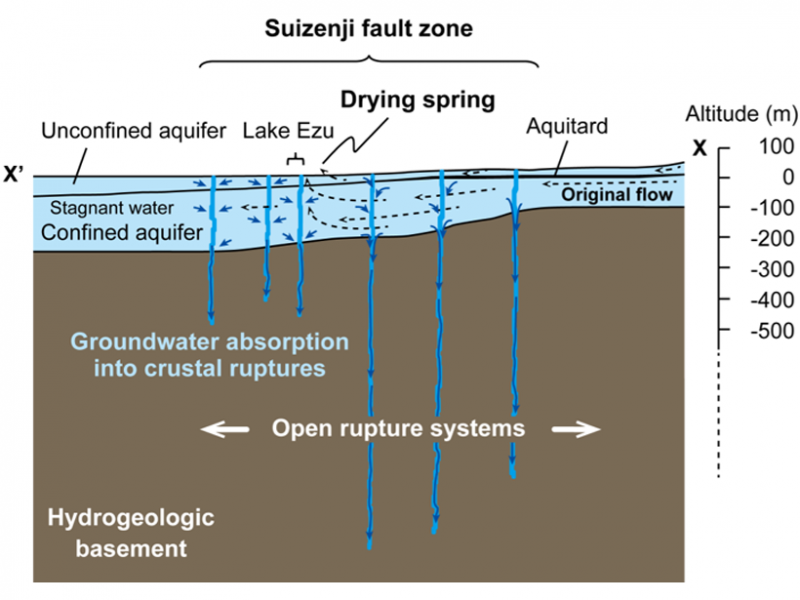Groundwater Drawn Downward After Kumamoto Quake
A unique set of high-frequency groundwater level monitoring reveals a loss of approximately ten million cubic meters of groundwater after a major earthquake.
SOURCE: Water Resources Research

There are many mechanisms that can explain a sudden water level drop after an earthquake. The unique dataset in this paper shows that the most likely cause of water disappearing is that it flows into crustal ruptures that are newly formed during the earthquake. Credit: Hosono et al. [2019], Figure 6
Major earthquakes are known to affect surface water and groundwater systems; for instance, by altering spring locations, making streams disappear, or causing groundwater levels to drop temporarily or permanently. The study by Hosono et al. [2019] is unique because it provides a rare set of high frequency observations of groundwater and surface water levels before, during, and after a large earthquake.
These data reveal that a large volume of water has disappeared through crustal ruptures formed during the quake, as shown in the diagram above. Not only does this reduce water availability in the region for a whole year but it also causes surface water and shallow groundwater to mix with deeper groundwater with possible long-term negative consequences for groundwater quality.
Citation: Hosono, T., Yamada, C., Shibata, T., Tawara, Y., Wang, C.‐Y., Manga, M., et al. [2019]. Coseismic groundwater drawdown along crustal ruptures during the 2016 Mw 7.0 Kumamoto earthquake. Water Resources Research, 55. https://doi.org/10.1029/2019WR024871
—Marc F. P. Bierkens, Editor, Water Resources Research
国外最新工作学习机会
1. Assistant Professorship in Climate-Related Sciences
Cambridge, Massachusetts
Massachusetts Institute of Technology (MIT)
https://findajob.agu.org/job/8010944/assistant-professorship-in-climate-related-sciences/
2. Assistant Air Quality Specialist/Air Quality Specialist (Advanced Monitoring Technologies)
Diamond Bar, California
$68,624.04 - $105,879.72 Annually
South Coast Air Quality Management District
3. Scientist – Terrestrial Hydrologic Science from Satellite Observations
Pasadena, California
Competitive salary with generous benefits package
Jet Propulsion Laboratory
4. Professional Staff - Materials Engineer/Scientist
Arlington, Virginia
$78,000 to $166,500 per year
U.S. Nuclear Waste Technical Review Board
https://findajob.agu.org/job/8010943/professional-staff-materials-engineer-scientist/



